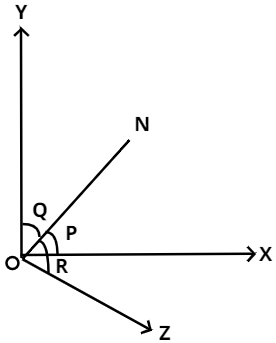
A straight line is equally inclined to all the three axes. Then the angle made by y-axes is
$
{\text{A}}{\text{.}}{\cos ^{ - 1}}\left( {\dfrac{1}{3}} \right) \\
{\text{B}}{\text{.}}{\cos ^{ - 1}}\left( {\dfrac{1}{{\sqrt 3 }}} \right) \\
{\text{C}}{\text{.}}{\cos ^{ - 1}}\left( {\dfrac{2}{{\sqrt 3 }}} \right) \\
{\text{D}}{\text{.}}\dfrac{\pi }{4} \\
$
Answer
218.7k+ views
Hint : Use the concept of direction cosines i.e. make the sum of squares of all the direction cosines as equal to one.

This the diagram of the line equally inclined to all the three axes.
From the Figure we come to know that ON is the line which is equally inclined to all the three axes.
Here we will use the concept of direction cosines $l,m,n$.
From the figure we know
$
l = \cos p{\text{ }}......{\text{(}}i{\text{)}} \\
m = \cos q\,\,\,\,\,\,\,\,\,\,\,\,......(ii) \\
n = \cos r\,\,\,\,\,\,\,\,\,\,\,\,\,......(iii) \\
\\
$
We also know ${l^2} + {m^2} + {n^2} = 1\,\,\,\,\,\,......(iv)$
From the question we come to know $p = q = r = \theta (say)\,\,\,\,\,\,......(v)$
From ${\text{(}}i{\text{),(}}ii{\text{),(}}iii{\text{),(}}iv{\text{)\& (}}v{\text{)}}$We do
${\cos ^2}\theta + {\cos ^2}\theta + {\cos ^2}\theta = 1$
$ \to 3{\cos ^2}\theta = 1$
Therefore,
$\cos \theta = \dfrac{1}{{\sqrt 3 }}$
Then ,
$\theta = {\cos ^{ - 1}}\left( {\dfrac{1}{{\sqrt 3 }}} \right)$
Hence the correct option is B.
Note :- In these types of questions we will always use the concept of cosines . That is the sum of squares of all the direction cosines is one. By using this we can get the answer easily . Drawing figures will make your concept more clear.

This the diagram of the line equally inclined to all the three axes.
From the Figure we come to know that ON is the line which is equally inclined to all the three axes.
Here we will use the concept of direction cosines $l,m,n$.
From the figure we know
$
l = \cos p{\text{ }}......{\text{(}}i{\text{)}} \\
m = \cos q\,\,\,\,\,\,\,\,\,\,\,\,......(ii) \\
n = \cos r\,\,\,\,\,\,\,\,\,\,\,\,\,......(iii) \\
\\
$
We also know ${l^2} + {m^2} + {n^2} = 1\,\,\,\,\,\,......(iv)$
From the question we come to know $p = q = r = \theta (say)\,\,\,\,\,\,......(v)$
From ${\text{(}}i{\text{),(}}ii{\text{),(}}iii{\text{),(}}iv{\text{)\& (}}v{\text{)}}$We do
${\cos ^2}\theta + {\cos ^2}\theta + {\cos ^2}\theta = 1$
$ \to 3{\cos ^2}\theta = 1$
Therefore,
$\cos \theta = \dfrac{1}{{\sqrt 3 }}$
Then ,
$\theta = {\cos ^{ - 1}}\left( {\dfrac{1}{{\sqrt 3 }}} \right)$
Hence the correct option is B.
Note :- In these types of questions we will always use the concept of cosines . That is the sum of squares of all the direction cosines is one. By using this we can get the answer easily . Drawing figures will make your concept more clear.
Recently Updated Pages
In a game two players A and B take turns in throwing class 12 maths JEE_Main

The number of ways in which 6 men and 5 women can dine class 12 maths JEE_Main

The area of an expanding rectangle is increasing at class 12 maths JEE_Main

If y xxx cdots infty then find dfracdydx A yxy 1 B class 12 maths JEE_Main

Chemical Properties of Hydrogen - Important Concepts for JEE Exam Preparation

JEE General Topics in Chemistry Important Concepts and Tips

Trending doubts
JEE Main 2026: Application Form Open, Exam Dates, Syllabus, Eligibility & Question Papers

Derivation of Equation of Trajectory Explained for Students

Hybridisation in Chemistry – Concept, Types & Applications

Understanding the Angle of Deviation in a Prism

Understanding Collisions: Types and Examples for Students

Understanding Atomic Structure for Beginners

Other Pages
JEE Advanced Marks vs Ranks 2025: Understanding Category-wise Qualifying Marks and Previous Year Cut-offs

How to Convert a Galvanometer into an Ammeter or Voltmeter

Understanding Centrifugal Force in Physics

JEE Main Marking Scheme 2026- Paper-Wise Marks Distribution and Negative Marking Details

Degree of Dissociation: Meaning, Formula, Calculation & Uses

Understanding Electromagnetic Waves and Their Importance




